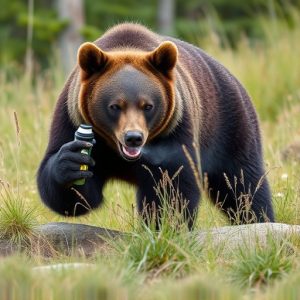Alaska Bear Repellent: Understanding Chemical Safety for Hikers
Bear spray is a vital tool for outdoor enthusiasts in Alaska, offering protection through synthetic…….
Bear spray is a vital tool for outdoor enthusiasts in Alaska, offering protection through synthetic pepper-based active ingredients like capsaicin, piperidine, and soy lecithin. Understanding these chemicals and proper spraying techniques ensures safe hiking. The primary ingredient, capsaicin, irritates bears' eyes and nose, while secondary chemicals create an unpleasant sensory experience. Not all sprays are equal; always choose approved repellents and follow manufacturer instructions for optimal protection. Knowing what chemicals are in your bear spray, along with correct application, significantly enhances safety during potential encounters in bear country.
“Exploring Alaska’s wilderness requires proper preparation, especially when bears roam freely. In this comprehensive guide, we delve into the essential aspect of bear repellents, specifically focusing on hiking gear and bear spray. Learn about the active ingredients in these powerful tools to keep you safe during your outdoor adventures. From understanding the chemical composition to choosing the right repellent and application techniques, this article ensures you’re equipped with knowledge for a secure hike in Alaska’s stunning yet wild landscape.”
- Understanding Bear Spray: A Necessary Hiking Companion in Alaska
- The Active Ingredients: Unveiling the Chemicals That Work
- Effectiveness and Safety: What You Need to Know Before You Hike
- Choosing the Right Bear Repellent for Your Adventure
- Proper Usage and Application Techniques for Maximum Protection
Understanding Bear Spray: A Necessary Hiking Companion in Alaska
Bear spray is an indispensable tool for hikers and outdoor enthusiasts navigating Alaska’s rugged terrain. Understanding its composition and effectiveness is key to ensuring a safe and enjoyable adventure. This repellent is designed to create a barrier between you and bears, deterring them from approaching. The primary active ingredient in bear spray is a synthetic pepper-based compound, often referred to as capsaicin. This chemical irritates the bear’s eyes, nose, and throat, temporarily disabling their sense of smell and vision, and causing them to retreat.
Beyond capsaicin, many brands incorporate other chemicals to enhance performance. These may include agents like piperidine or soy lecithin, which aid in breaking down the spray’s particles, ensuring maximum coverage on the target animal. The effectiveness of bear spray lies not only in its chemical composition but also in proper usage. It’s crucial to learn how to spray correctly during encounters, aiming for the bear’s face and eyes, and following manufacturer guidelines for best results.
The Active Ingredients: Unveiling the Chemicals That Work
When it comes to bear repellents, especially for hiking gear, understanding the active ingredients is key to knowing how effective a product will be. Bear spray, a common form of protection, relies on specific chemicals to create a defensive barrier against potential encounters with bears. The primary active ingredient in most commercial bear sprays is capsaicin, derived from chili peppers. This chemical irritates a bear’s eyes and nose, temporarily distracting it and encouraging a quick retreat.
Additionally, many bear sprays incorporate other chemicals like piperidinyl butyl carbamate (ABC) or tetramethyl ammonium bicarbonate (TMAB). These substances work by creating an unpleasant sensory experience for the bear, often described as a burning sensation. The combination of these chemicals in bear spray has proven to be highly effective in deterring both black and grizzly bears, making it an indispensable part of any hiker’s safety kit when venturing into bear country.
Effectiveness and Safety: What You Need to Know Before You Hike
Before venturing into Alaska’s wilderness, understanding the effectiveness and safety aspects of bear repellent hiking gear is paramount. Bear spray, a common defense against aggressive bears, contains potent chemicals designed to deter attacks. However, it’s crucial to know that not all sprays are created equal; components like capsaicin, olapam, or pepper-based agents are typical ingredients known for their effectiveness in provoking a bear to retreat.
Safety comes first when using any repellent. Users should practice proper handling techniques and familiarize themselves with application methods. It’s important to remember that while bear spray can significantly reduce the risk of attacks, it may not always guarantee complete protection. Always stay alert, make noise during hikes, and carry other forms of protection as backup.
Choosing the Right Bear Repellent for Your Adventure
When planning a hike in bear country, selecting the suitable bear repellent is paramount to ensuring your safety. Bear spray, a popular choice, is designed to deter and protect against aggressive bears. The effectiveness of bear spray lies in its active ingredients and chemical composition.
Understanding what chemicals are in bear spray is key. Common active ingredients include capsaicin, a compound found in chili peppers, and various types of peppers like cayenne or horseradish. These substances create a burning sensation when inhaled by bears, causing them to retreat. Some bear sprays also incorporate ultraviolet (UV) dyes that can mark the bear’s fur, helping rangers identify and track potential problem bears. Always opt for a repellent approved by relevant outdoor authorities and follow the manufacturer’s instructions for optimal usage and safety.
Proper Usage and Application Techniques for Maximum Protection
To ensure maximum protection, understanding how to properly use and apply bear repellent is paramount. When hiking in areas known for bear activity, it’s crucial to follow the manufacturer’s instructions on the product label. Typically, this involves spraying directly towards the bear’s face from a safe distance—often recommended as 20-30 feet (6-9 meters). Bear spray is designed to create a barrier of irritants that deter bears from approaching.
The effectiveness of bear repellent hinges on the chemicals present in the spray. Common active ingredients include capsaicin, a compound found in chili peppers, and various types of aerosols. Proper application techniques, combined with knowledge about what chemicals are in your bear spray, can significantly increase your safety during encounters in Alaska’s rugged wilderness.
When hiking in Alaska, bearing the right gear is essential for a safe and enjoyable experience. Understanding bear spray, its active ingredients, and proper usage can significantly reduce the risk of encounters with these powerful animals. Remember, knowledge is your best defense; choose a high-quality bear repellent, familiarize yourself with its application technique, and always follow safety guidelines. With the right preparation, you can hike with confidence, appreciating Alaska’s stunning landscapes while minimizing potential dangers from bears.


